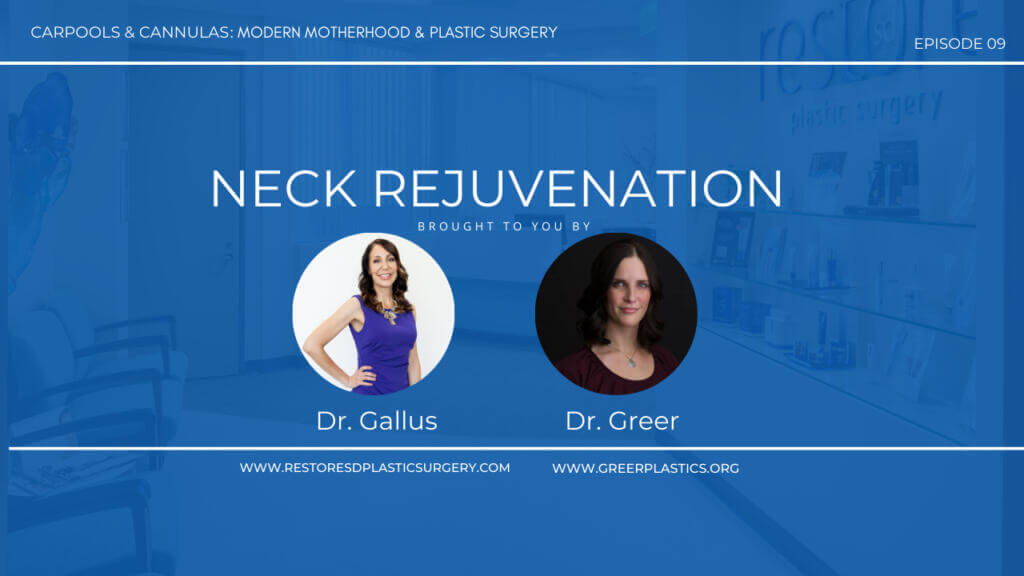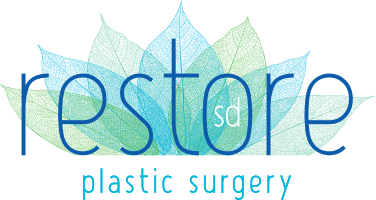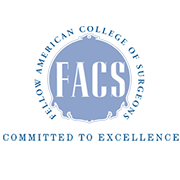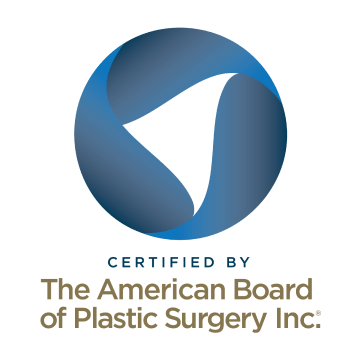You won’t want to miss this episode of Carpools & Cannulas: Modern Motherhood and Plastic Surgery! Dr. Greer hosts this episode (with a guest appearance from her son) as she and Dr. Gallus talk about the neck – how it is different from the face in how it ages and what options are out there to improve common complaints like neck lines, sagging necks and double chins.
Transcript
Dr. Greer: Hello, everyone. We are doing another “Carpools & Cannulas” and Dr. Gallus will be joining me momentarily, which will be exciting. We’re talking all things neck tonight. Wow, my hair’s kind of frizzy, huh? That’s cool. Oh, here we go. Let me pull her on. I was snuggling with my kids before this, so, you know, that’s how it goes. Frizzy hair when you’re snuggling with kids. All right, Dr. Gallus is coming on. Hello.
Dr. Gallus: Hey. We have matching messy buns.
Dr. Greer: I know, I was like, I’m looking. I was like, you can tell I was snuggling. It’s okay. How’s traffic? Terrible?
Dr. Gallus: It was okay. It was fine. I just, it’s always a struggle. This day, I’ve been running late the whole time. This morning anesthesia was late for my case, so I kind of strolled in 20 minutes late. And then…
Dr. Greer: Hey Savvy, and then was like, oh yeah, because it’s a big group of anesthesiologists, so you get a new one every time. He’s like, “Yeah, you’re good to take her back.”Like he thought I was the nurse.
Dr. Greer: Oh, right, you’re like…
Dr. Gallus: So it happens all the time, yeah.
Dr. Greer: Isn’t it so funny? Like, people have no idea.
Dr. Gallus: I was like, “I’ll go get the nurse to do that, but, thumbs up.”
Dr. Greer: Hi. I have Wyatt today. Dr. Gallus says hi. He needed extra snuggles so I’m on the couch, which is why my view’s a little bouncy. But that way he can snuggle, right bud?
Wyatt: Yeah. Mommy.
Dr. Gallus: Yeah, Wyatt. Cute. So yeah.
Dr. Greer: That’s fun.
Dr. Gallus: Right? I’m like, well this should be entertaining. He ended up being fine, but you know.
Dr. Greer: Yeah it’s…oh, look, Erin said hi, Wyatt. She’s in California, so is Dr. Gallus. They said hi to you, dude.
Wyatt: Hi.
Dr. Greer: He says hi.
Dr. Gallus: That’s right, at the OR tech I work with at that other place, Savvy, who’s amazing. It’s like, that would never happen with us.
Dr. Greer: That’s so funny. I know it’s so different. Like the different places you go. I just switched hospitals for my big cases. Because I do most of my stuff at a surgery center where I’m one of the owners, but anything over four and a half hours they want chief medical officer approval.
Dr. Gallus: Oh, really?
Dr. Greer: Yeah. Which, I mean, I get it. Those are long cases and they’ll approve most stuff in young and healthy people. But I have hospital privileges at one of the local hospitals and I just switched to another hospital like in the system that doesn’t have ER call requirements and is seven minutes from my house and it’s a really nice place. So, they’re still getting used to my routine. I’m figuring out what I need. It’s always so different.
Dr. Gallus: Oh, yeah. Whenever, I mean, even a couple of years ago I went somewhere to the hospital where I have privileges and they were like, they knew I wasn’t a nurse there because I was, you know, it’s a small enough surgery center that they know everybody.
Dr. Greer: Right, they knew who you were.
Dr. Gallus: So they were like, “Are you the PA that’s assisting Dr. So-and-so today?” And I was like “God, why can’t I just be the surgeon?”
Dr. Greer: Right. Because girls can be doctors. Actually. I saw a patient today who drove an hour to come to see me for surgery. And she’s like, “There are not many women plastic surgeons.”And I told her, I was like, “It’s changing, it’s going to be better. But you’re right, there aren’t enough of us.”
Dr. Gallus: Yes. That’s so true.
Dr. Greer: Yeah.
Dr. Gallus: So, okay. So we were going to talk about necks, right?
Dr. Greer: Yes. Necks are a big topic. There’s a lot of real estate there to cover.
Dr. Gallus: Let’s start. What do you do for noninvasive for neck?
Dr. Gareer: We used to offer SkinTyte, which was on the Sciton. It was, like, okay. I don’t know. My thing with all the noninvasive is some people respond great, some don’t. You can’t always predict. So when I got a new Sciton we didn’t get the SkinTyte. So I do peels, I’ll do Halo peels, which are fractionated and tucks in for platysmal bands. These are platysmal bands, guys.
Dr. Gallus: Yeah, I have got those ones.
Dr. Greer: So I’ll do tucks in for those. That’s really it. I’ve done dilute Radiesse elsewhere, but I’ve heard not awesome things about the neck. About it may be getting…
Dr. Gallus: I struggled, yeah, I tried it because it seems like such a great idea.
Dr. Greer: Idea. Yeah.
Dr. Gallus: So, I know you guys are like having fun in the comments.
Dr. Gareer: Probably in the comment section. I know, then we get distracted reading.
Dr. Gallus: So I agree. Well, I will say sunscreen, right? Because people forget.
Dr. Greer: Oh, yeah, well skincare. I know you mentioned on our skincare talk like I’ve been much better about carrying my products down onto the neck.
Dr. Gallus: Right.
Dr. Greer: Because it’s terrible like your face looks perfect. And then your neck is all creepy.
Dr. Gallus: I did do a neck lift for a patient who had had…
Dr. Greer: Oh, you’re sweet, I’m good, thanks though. They’re having full-on snacks here.
Dr. Gallus: Aggressive laser treatment elsewhere did a great result, but you know, they blasted her face and she looks like really tight. And then the rest was, you know, her 60-year-old neck, and you can’t really blast the neck that much, but yeah. So you want them to kind of match a little bit. So sunscreen obviously. We have Alumier, we both carry. The neck cream is nice, has a little bit of retinol in it. So, that’s helpful.
Dr. Greer: Yeah, I actually just put the regular retinol on my neck. I can’t, I’ve tried it on my chest though, and it’s a little irritating. Yes, well, laser will help improve the texture of the neck. So when we talk about like, and this is a good topic for faces too, lasers for re-texturing, it doesn’t do a ton of tightening, but it will help the crepey texture. And then if you have an actual laxity that you can pull then you’re talking surgical, most of the time, although I’m sure we’ll talk about FaceTite and you know, RF.
Dr. Gallus: Move on, you have other options.
Dr. Greer: Yeah. All that stuff.
Dr. Gallus: But yeah. So if you have that thin crepey skin, which is contributing is a sign of sun damage…
Dr. Greer: Sun damage-
Dr. Gallus: …and collagen and elastin not being 100% and is contributing to some laxity, then you can stimulate collagen by lasering that area. But the neck is different from the rest of your face as it doesn’t have the same appendages that your face does which is how you heal from, like, a fractionated laser. So you can’t hit it as hard, otherwise, it won’t heal and you can get into trouble that way. So you’re in a tough spot.
Dr. Greer: Right, which, it seems counterintuitive. You feel like your face would be more sensitive but it actually heals much more quickly.
Dr. Gallus: Right. Yeah. The neck skin is really thin and just doesn’t heal as fast. So yeah, so I think laser’s okay for just keeping everything like, you should bring it down to the laser. The best laser? I mean, I think CO2 is probably the best, fractionated CO2 to like simulate.
Dr. Greer: I don’t know, I have a…oh, my husband’s taking pictures of me because I have a kid with snacks, puppy on my feet, like pillow in my lap with my phone stand. It’s hilarious. But okay, so I have an Erbium, I’m a fractionated Erbium girl because I have the Sciton. And I think some people would argue that it has a higher affinity for water and less thermal spreading.
But, the point is, with stupid smiles, the point is really lasers are all a way of inducing targeted damage, and the particular type of laser doesn’t necessarily matter so much as if you’re doing like fractionated versus non fractionated, ablative versus nonablative. So I would say, like CO2 versus fractionated Erbium are probably going to be pretty similar in terms of results.
Dr. Gallus: Right, than a fractionated CO2. Yeah, I mean, they both target water so it’s just a different mechanism. And I would say IPL is really not a great option for skin tightening for the neck. So like if you’re gonna, that’s the other big laser that gets thrown around, right. So you’re gonna…
Dr. Greer: Yeah, although I, you know, I do that one a lot as maintenance. And so I have a Sciton which is a whole thing in and of itself and they have a treatment protocol called the Forever Young BBL and that does build a lot of collagen long-term. So I never tell people to expect in the short term that they’re going to see tightening, but if they get it 2 to 3 times a year, in 10 years their neck’s going to look better than it does now. So it’s a really good preventative.
Dr. Gallus: Oh, okay. So Ovation Hair which is also known as my sister, is asking about the recovery time for a neck lift. So that is, we haven’t asked that yet. Asking for a friend.
Dr. Greer: Asking for a friend.
Dr. Gallus: She’s asking for my mom.
Dr. Greer: Nice.
Dr. Gallus: So two weeks of nothing aggressive, right? So, can’t raise your heart rate, can’t raise your blood pressure. You don’t really feel like doing too much either after that for the first two weeks. And then, I tell people at three to four weeks you can start increasing your activity. And it just depends a little bit, whenever you do the face or neck, how concerned you are with other people knowing you had surgery because it’s at least three weeks before you can get away with people not noticing.
Dr. Greer: Can kind of hide it. Yeah. And I will let people do light walking at a week out. And like, you can get back to work at that point, but again, it’s totally your comfort level. It’s more of a social recovery is what I heard it termed when I was in med school, which I thought was a great term.
Dr. Gallus: That’s, yeah.
Dr. Greer: Yeah. Because you feel okay, your neck feels really tight and like ears feel plugged up, is what my patients complain of because of the swelling. But actually saw someone today who was two weeks out. And she had full makeup on. And really you could not tell. But she was healing quickly.
Dr. Gallus: Yeah. I’ve had some patients that have gone back to work after a week, but that was with remote work, so.
Dr. Greer: Yeah, which makes it easier.
Dr. Gallus: It’s a little like fix the filter on the Zoom, or maybe we have the camera off a little bit, but you feel okay, you just can’t…And then in La Jolla where, you know, I’m in Southern California, sometimes people are out and about like, it’s almost like a badge of honor.
Dr. Greer: Badge. Oh yeah.
Dr. Gallus: Like, I have a drain coming out of my head.
Dr. Greer: My bruise, it’s fine. It’s totally normal. I remember seeing somebody In-N-Out Burger with their nasal splint on after rhinoplasty.
Dr. Gallus: They’re like, “No, no, no.”
Dr. Greer: It’s fine. It is interesting because for neck lift and facelift the bruising’s all down here pretty much, even for facelift because it’s very gravity dependent and then it drifts down onto your chest. So, you know, if it’s a cold day out and you put on a scarf and your hair’s down to cover the incisions here it’s pretty easy to hide, I think.
Dr. Gallus: Yeah. Yeah. The scarf sunglass thing. If you have any eye surgery, you can get away. You can go far with that.
Dr. Greer: You can.
Dr. Gallus: So that’s the gold standard, right, is…
Dr. Gallus: Neck lift.
Dr. Greer: Neck lift surgery. And I don’t know about you, but I get a lot of questions about a mini neck lift. I don’t, there’s no definition for that.
Dr. Greer: No.
Dr. Gallus: I call it a lower face and neck lift. So for me, that incision is still in front, behind the ear, and back here because I can’t do this…
Dr. Greer: You can’t get access.
Dr. Gallus: …without, through a tiny… I mean, if you’re doing that, my imagination is that you’re just coming here, grabbing the platysma and pointing it up maybe. And that’s it.
Dr. Greer: We share the exact same definition of a mini face and neck. Yeah. I just elevate a lot less, grab the lateral platysma. Whereas, if I do a full face and neck lift I’m elevating a lot here. I still do the lateral platysmal plication, but I’ve switched to the Italian facelift technique, which I really like. There’s this paper that was by a bunch of Italian doctors.
Dr. Gallus: Italian.
Dr. Greer: So we call it the Italian facelift, I think. But it’s nice. And what I love is how easily you can divide the platysma here to get rid of the band. So these bands, I keep demonstrating for you, guys, show up and they start hanging as things get lax. And what we do is divide the muscle and the bands disappear. And then we tack it up to the fascia of your sternocleidomastoid and your mastoid process back here. And that’s what gives everything that tight look. It’s pretty awesome.
Dr. Gallus: Yeah. I like using that technique too. And I think that helps, I think there’s this truck or something going by, sorry.
Dr. Greer: It’s fine.
Dr. Gallus: That divides the platysma so that it doesn’t, I mean, because the traditional neck lift is grabbing that lateral platysma and pulling it up and then also doing a corset platysmaplasty. So an incision under your neck. And then, I think I can demonstrate the bands too,
Dr. Greer: There you go, we’re good.
Dr. Gallus: You suture them together in the middle. But then you’re pulling them in both directions, and I feel like that ends up coming back.
Dr. Greer: Yeah, and well it’s really hard to do this part. I always found that part to be kind of a – oh, sorry, child here. To be kind of a pain in the butt, just to get in there because it’s really narrow. And coming in from the side I feel like you get really good visualization. You know the whole platysma is divided. It’s just a little bit more straightforward technique. But yeah, it’s actually the muscle layer that we’re lifting and that’s what gives it its longevity. Because if you just tighten the skin, it will stretch back out.
Dr. Gallus: Right. Especially if you already have that sun-damaged, you know, kind of aging skin. It just doesn’t have the same resilience as normal skin.
Dr. Greer: Right. It’s like a balloon that’s been blown up and then deflated.
Dr. Gallus: Yep. Okay.
Dr. Greer: I saw an interesting Instagram video yesterday actually where somebody had all those neck creases, and I’ve never had a great correction for those, and they put a little bit of filler all the way across. But then they did the threads to build collagen, and I don’t love the threads because I feel like, foreign body reaction, sometimes harms.
Dr. Gallus: Yeah I don’t love threads either.
Dr. Greer: Yeah. But I think, and I could see adding some, like, Restylane in there.
Dr. Gallus: I feel like it’s a slow go for the neck lines. And honestly, I have patients that are young that have them and then you’re like, it’s the tech neck, you know? Your head is always like this, so you’re kind of always recreating those. Like you’re never stopping. Whereas for these lines, you can Botox and paralyze that and it stops, but this is just kind of like a natural crease and it’s really hard to undo. You do want to stimulate collagen.
Dr. Greer: Right because you’re just going to keep creasing. Yeah.
Dr. Gallus: So I have tried, I’ve tried the Plasma Pen, not impressed. Laser helps, but it’s more of a global thing. Dilute Radiesse has its own headaches.
Dr. Greer: Right. Because it can kind of bunch up where things move and crease.
Dr. Gallus: Right. Yeah, I don’t have a perfect answer. You can put fat, you can do dilute Restylane or Restylane and then, and/or fat if you’re there for some other reason, maybe you layer it underneath there. I think that’s probably not a bad idea. But yeah, that’s a tough one.
Dr. Greer: Yeah. Necks are tough.
Dr. Gallus: Where it’s like somebody comes in with a little waddle, that’s easy. That’s a little liposuction and you can…
Dr. Greer: Tighten that right up.
Dr. Gallus: …tighten up.
Dr. Greer: Yeah, I think the biggest thing with necks is the sunscreen and prevent the sun damage. Because once it’s there, it’s hard to undo.
Dr. Gallus: Mm-hmm. Yeah. So with noninvasive, so the middle ground between like, wear your sunscreen and you need surgery I feel is the FaceTite or I have the Renuvion which is formerly known as J Plasma. And that’s a…
Dr. Greer: And that one’s under the…you can…well, that one’s under the skin but you can do a peel with it too. Right?
Dr. Gallus: Yeah. So yeah, with the device you can, not for the neck though. It’s super powerful, so.
Dr. Greer: Yeah, it’s very aggressive.
Dr. Gallus: Too strong.
Dr. Greer: How do you like it?
Dr. Gallus: I like it a lot. I think I use it a lot with liposuction, in conjunction with liposuction and I’ve done a handful of necks with it too for… You just have to find the right candidate because you’re going to get some tightening, but you’re not gonna, you know, it’s somewhere in between you know, Botox, fillers, peels, all that stuff, and surgery. So if you’re really committed to not having surgery and you want just a little tightening or you’re a little on the young side, then it’s a great option.
Dr. Greer: Yeah. Although that’s still going under the skin. So like they’re still an incision, tissue still getting elevated.
Dr. Gallus: Sure. I consider it minimally invasive. I could do it awake. I make a little incision here and one behind each ear. And then you just, you have to infiltrate like you’re gonna do liposuction, and create those pathways.
Dr. Greer: Right, so it’s numb.
Dr. Gallus: Mm-hmm. And then you pass the wand and you just continue to heat the skin, kinda like this. And then another one like that. And then presto, you can see immediate tightening and then it tightens again over the next three to six months, so.
Dr. Greer: Nice.
Dr. Gallus: In and out, it can be done awake which people like, people are pretty comfortable. We do it in our procedure room, under light sedation meaning you can take, you know, those MKO melts, but basically, a margarita and a pill. And then once we get you numb, it’s fine. Like, most people are cool.
Dr. Greer: Right, it’s the numbing.
Dr. Gallus: So yeah. So I feel like that’s a good halfway point for patients for that. I would say the other common not like minimally invasive thing like I said is submental liposuction, which you can also do under local. Right?
Dr. Greer: Yeah. If you just have fullness here, it’s remarkable how much tightening you can get once you lipo that aggressively. But I will say though, you know, with my facelift and neck lift results, I feel like earlier is definitely better. If you’re wondering when to get that done. Like once you have that, grab-able…Like I had a patient whose complaint was that her neck like flapped in the wind on her motorcycle, it was a legitimate thing. And you know, you can improve that pretty drastically but it doesn’t get as tight, you know? It’s just not like, it always recurs a little bit here. And then I’m always really excited with the results. And then two months later I’m like, “Oh, it came back a little,” and it always does just because of skin stretch.
Dr. Gallus: Yeah, there’s always a little here. I mean, it’s going to re-stretch. And I do agree, the older you are unless it’s your third facelift, the more laxity you’re going to have because your skin is just not going to hold in place. So don’t wait and hit the panic button, you know, way beyond your years or at least be doing other things to maintain it, so yeah.
Dr. Greer: Right. Like laser and skincare. Yeah. I mean, once you have like a little bit, it’s okay, it’s time. You can, you’re not pulling the trigger too early. Not that you have to, people, it’s fine to have an aging neck. But if it bothers you, then it’s not too early.
Dr. Gallus: Yeah, but don’t wait too long. Yeah, for sure.
Dr. Greer: Although I have to say I’ve had a couple patients in their 30s and 40s who just genetically were blessed with extra skin here, who just got a huge transformation from that. And it had nothing to do with age or sun damage. It was just thanks to their parents.
Dr. Gallus: Yeah. I have a couple of patients like that too, where they’re like, “Listen, it’s my mom, like everybody in my family has this neck and they’re in their early 40s.” And you’re like, “Okay.” I remember seeing how old they were and like, “No, no, no.” And then you walk in and you’re like, “Oh yeah, that would really help.”
Dr. Greer: Right? You’re like, “Yeah, no, I can help with that.”
Dr. Gallus: And it’s great because they’re already, like, everything else is good. You know.
Dr. Greer: Right. And their skin usually has really good elasticity too. Oh, you know what we should talk about too, is CoolSculpting on the chin. It’s not neck per se, but, do you have CoolSculpting?
Dr. Gallus: I don’t, but yeah, I was going to say, I just answered, no, I just fielded that question today or the other day. I was doing Botox. I think it was…just two patients in the room, maybe it was mother, daughter, or something. And then they were like, or two friends, “What can we do for under here?” And I’m like, “Can I finish treating you?” But yeah, I would say there’s three things liposuction, which we talked about, right? Is, you know, kind of one-and-done, can be done under local, I think that’s a great result. CoolSculpting which I don’t have.
Dr. Greer: Yeah, there is some swelling there with the lipo and some bruising, yeah. But not bad.
Dr. Gallus: Yeah, for sure. It’s not like a zero…
Dr. Greer: And then CoolSculpting. Yep. And then Kybella. Right? Is that where you were going with that?
Dr. Gallus: Mm-hmm. So CoolSculpting, what do you tell…Since I haven’t done it before, once you’ve done the treatment, is it red and swollen afterwards or not really?
Dr. Greer: Immediately afterward, yes. The goal is red and swollen. But we did Kybella a few times before we got CoolSculpting. And with that, you’re kinda like bull froggy because it’s putting a lot of volume in. CoolSculpting is definitely less than that. I will say it is probably the least comfortable area to get CoolSculpted. Sorry, the couch is shaking the dog is digging at my feet. So, after the applicator goes on, it gets numb, and then when we take it off, we aggressively massage because that kills more of the fat cells, and that part’s kind of nauseating under the chin from what I hear.
Dr. Gallus: Yeah, that would be tough.
Dr. Greer: Yeah. But there’s two things I love about CoolSculpting…things are getting kicked, versus Kybella. So with Kybella, you have to stay really centrally. The marginal mandibular nerve yaw comes in here and it can be injured with Kybella and then you end up with like asymmetry which is not cool. With CoolSculpting, we’ve put the applicators right along the jawline and in the center so you can get beautiful jawline definition.
Dr. Gallus: Oh, nice.
Dr. Greer: Yeah, it also has an FDA approval for mild skin tightening under there. So you do get some improvement in laxity. So I really, I’ve gotten some fantastic results under the chin with that. And I’ve had some patients, again like late 20s, who just like looked 20 pounds heavier than they were because of that, and we were able to give them some really nice jawline definition.
Dr. Gallus: Oh, that’s awesome.
Dr. Greer: Yeah, and if you combine that, like if somebody has got kind of a retrusive chin and you add some Restylane define there…
Dr. Gallus: A little filler.
Dr. Greer: …and, you know, maybe in that pre-jowl sulcus, you can really make a very nice improvement without surgery. Although the filler will have to be redone, but the CoolSculpting results will last.
Dr. Gallus: And then, do you find with the CoolSculpting, is it one treatment in most patients? Or do they…
Dr. Greer: It’s usually two. I always recommend two. It’s like, you know, you’ve got to get enough cycles on there to get an improvement. And I used to try to skimp a bit and just do one session, it was just not enough.
Dr. Gallus: Hmm. And how long before they get to that result like when you do the treatment?
Dr. Greer: So they have a session, four weeks later they have the second session. Usually, by that second session, they are starting to see an improvement. And then it’s three to five months for final results. But like things gradually and steadily improve. When I did my arms like by the month part, it was like, “Oh, okay. I can see a difference.”
Dr. Gallus: Cool.
Dr. Greer: So, yeah, it’s a nice technology.
Dr. Gallus: Hmm. Okay. Yeah. So I tell people that it’s one of the options I don’t have, but it’s still an option. And then Kybella, which is a little less predictable because I think you’re injecting, you know, you’re injecting a certain amount of pharmaceutical, and then it’s knocking off fat cells and your body has to clean it up. So you get that bullfrog for two weeks. And then it’s definitely three treatments. I think if you try to scooch, you know, scooch under that then people are disappointed.
Dr. Greer: It’s not, yeah.
Dr. Gallus: So I don’t know, it adds up in expense. Like, I think some people also equate like, the less downtime or the noninvasive aspect with it with being cheap.
Dr. Greer: With less expensive.
Dr. Gallus: It’s not.
Dr. Greer: Yeah. It’s the same thing for CoolSculpting, people expect it to be less than lipo and it is equal or more depending on how many areas you get. Yeah. And it’s interesting because I expected it to be less expensive too and I’m kind of wondering like, “Well why did I think that? It cost them millions of dollars to come up with the technology and test it.”
Dr. Gallus: Right, right. It’s ridiculous.
Dr. Greer: Of course, of course, it’s expensive. Yeah. Erin, you are not too fat for CoolSculpting, stop it. A-Types. Actually, you know, that brings up a really interesting point though, Erin, because, so for CoolSculpting the ideal BMI is like 30 or under. For chin, it doesn’t matter. Like, I’ll do it because, and here’s the thing, the fat’s not that thick under the chin, it’s just not. The cold can only penetrate so far. So if you have a really thick layer of abdominal fat it’s gonna take you, you know, double the sessions to get the same result…
Dr. Gallus: Right, I was going to get into that.
Dr. Greer: …as someone who’s thinner. Yeah. Because you’re only getting that 25% reduction as far as it penetrates, but on the chin that fat’s never thicker than the cold will penetrate, so I can get great results even if somebody’s got a BMI above 30, under the chin.
Dr. Gallus: Yeah. That’s a good point.
Dr. Greer: Yeah. Yeah. It’s kind of interesting. Yeah. I can tell, I can see your cheekbones on your tiny icon picture, so, okay.
Dr. Gallus: What is the most popular area that you CoolSculpt, then?
Dr. Greer: Abs, although under the chin is popular and I love arms too. I mean, they just, the only thing is you really have to, you know, if you’ve got fat, like on the top of your arm you really have to circumferentially lipo that. I’ve learned from Dr. Gruber who does awesome arms. But if it’s just the back of the arm, like you can see I have no fat there, that was CoolSculpting.
Dr. Gallus: Okay, cool.
Dr. Greer: So yeah. It’s incredibly effective and you really have to be careful how you make the treatment plan so that you get a smooth contour.
Dr. Gallus: And then do you do it, or do you have somebody in your office is the CoolSculpting queen or king?
Dr. Greer: I do. My CoolSculpting queen is Christi. So I’ll have to tag her later. She started out as my part-time aesthetician receptionist then became the CoolSculpting queen. I still do all the consultations and create all the treatment plans, but she has like an eye for fat and she is phenomenal with the machine, so.
Dr. Gallus: Yeah. And I know that’s a big part of it too.
Dr. Greer: It is. You really have to have somebody who has got a passion for it and enjoys doing it. I’m fortunate that I have her.
Dr. Gallus: Yeah. That’s pretty cool. We were just toying around with the idea of this other machine that uses Nd:YAG to generate heat and penetrate the skin, and then also melt fat. But I think we’re probably not going to go there. But it’s interesting. Like we’re always looking for the… I know.
Dr. Greer: It’s hard. There’s like so much technology and we all want the magic.
Dr. Gallus: Where’s my magic wand? Where’s my magic wand?
Dr. Greer: I know, like, people think they want the magic. No, we as doctors want the magic too. We wanna get rid of the cellulite and melt the fat without surgery and tighten the skin without surgery. Like we love that too.
Dr. Gallus: Yeah. We’re behind you.
Dr. Greer: Not only just for ourselves. Yeah. But yes, it doesn’t exist yet.
Dr. Gallus: We’re willing to be guinea pigs, even, to figure that out.
Dr. Greer: Oh my gosh. What have I not tried on my own face?
Dr. Gallus: Right? I know. Yep. I was inspired. I have RHA 3 in my lips from after when you did yours.
Dr. Greer: Nice! I like it, it’s so flexible. I really like it. Yeah. It’s nice for, I like it in smile lines too. Because it’s very natural and flexible there. I would say similar to Restylane Refyne, which is also… There’s like this whole chart that one of my reps I probably shouldn’t mention which one…
Dr. Gallus: Oh, I’ve seen that.
Dr. Greer: Yeah, where it compares…I know we get off on tangents but this is why we like hanging out. It compares the G prime, which is the structural support of a filler versus the elasticity, which is how much it stretches. And it’s nice because all the fillers are right on there and you can say, “Oh, I’m doing a really flexible area. Oh, but I need more support.” And like pick your filler out. It’s the best chart.
Dr. Gallus: It’s interesting where products land too. You’re like, “Oh, I thought that would be, more like, what ends up being next to each other brand-wise?”
Dr. Greer: Yeah. Regular Restylane and Restylane Lyft, which is a cheek filler, have like, almost the same G prime in terms of structural support. Yeah. It’s fascinating.
Dr. Gallus: Your dog is not impressed.
Dr. Greer: I’m sorry about the barking. My husband’s literally been here all evening and my dog just discovered him.
Dr. Gallus: Oh. There’s my dog. Billy’s here.
Dr. Greer: Aw.
Dr. Gallus: Back to us. Bills, what are you looking at?
Dr. Greer: They’re so funny.
Dr. Gallus: She’s busy watching the door for me. I don’t know what’s happening there.
Dr. Greer: Aw. Here, wait, I’ll flip my camera and you guys can see my dog. There he is. He’s at my feet.
Dr. Gallus: Aw.
Dr. Greer: Yeah, you’re like looking past my little ring stand. Okay. Oh, and there’s Wyatt’s hand, and here’s Wyatt. Yeah, it’s a busy house here.
Dr. Gallus: He’s helping, he’s your camera guy.
Dr. Greer: Yeah, he is.
Dr. Gallus: Totally.
Dr. Greer: He’s my handsome dude. He won’t need a neck lift ever. You have a great neck.
Dr. Gallus: So what are we going to talk about next time?
Wyatt: Wait.
Dr. Greer: Gosh, so we’ve done neck.
Dr. Gallus: We’ve done eyes, neck.
Dr. Greer: We haven’t done anything breasts in a while, have we?
Dr. Gallus: Yeah, let’s go back to breast.
Dr. Greer: Okay. I mean, I love breast. Breast surgery is like, my favorite, it’s my very favorite. We could talk about like maybe lift versus reduction. Because that confuses a lot of people.
Dr. Gallus: Oh yeah. I think so.
Dr. Greer: Yeah. Because people are like, “Well, do you lift them when you reduce them?”
Dr. Gallus: I know I’ve started to learn to add that in there because they just…we’re talking reduction because I know what I’m doing and then I’m like, “Oh yeah, we’re gonna make that smaller [crosstalk 00:28:48].”
Dr. Greer: You don’t know what I’m doing. Yeah. Okay. Well, we can talk about that and it’ll be your turn to host. It’ll be fun.
Dr. Gallus: Okay, cool.
Dr. Greer: Awesome.
Dr. Gallus: Oh, Erin wants to know what kind of dog you have. Is it a Poodle?
Dr. Greer: Oh, good call, Erin. He is a Schnoodle. He’s a Schnauzer-Poodle mix. They’re like fantastic with kids. What about eyes?
Dr. Gallus: Oh, stop.
Dr. Greer: Didn’t we talk about eyes, like, two times ago?
Dr. Gallus: Yeah, we can revisit eyes but…
Dr. Greer: Always.
Dr. Gallus: …I think we’ll go back to breasts. We’ll end up around eyes again, I’m sure.
Dr. Greer: Yeah. That’ll be fun. Awesome.
Dr. Gallus: All right. Cool. Cool. It was good talking to you, have a good night.
Dr. Greer: Well, have a good night. It was good to see you too, and thank you guys all for watching.
Dr. Gallus: My dog fell asleep. Yeah, thanks, everybody, for participating, we love that.
Dr. Greer: We do. We love to have an audience.
Dr. Gallus: DM us if you have ideas about topics.
Dr. Greer: For sure, because we would love to hear them.
Dr. Gallus: All right.
Dr. Greer: All right. Have a goodnight.
Dr. Gallus: Peace out.
About Restore SD & Dr. Katerina Gallus
As the Director of Restore SD Plastic Surgery, board certified female plastic surgeon Dr. Katerina Gallus has over 15 years of experience helping San Diego women enjoy head to toe rejuvenation with face, breast and body procedures. After a successful career as a Navy plastic surgeon, Dr. Gallus founded Restore SD Plastic Surgery with the intention of creating a welcoming space for anyone seeking cosmetic enhancement.
Restore SD Plastic Surgery offers popular facial rejuvenation procedures like facelift & neck lift, facial fat grafting, and eyelid lift; breast augmentation with implants, breast lifts or breast reduction; body contouring procedures such as tummy tuck, liposuction, mommy makeover, and Brazilian butt lift (BBL), as well as aesthetician services, BOTOX, injectable fillers, and laser treatments.









